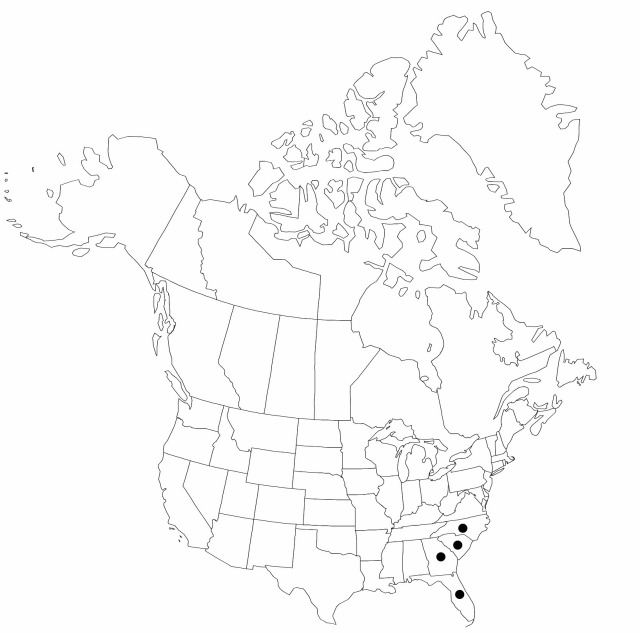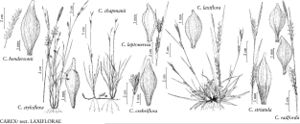Difference between revisions of "Carex chapmanii"
Syn. Pl. Glumac. 2: 222. 1855.
FNA>Volume Importer |
imported>Volume Importer |
||
| (5 intermediate revisions by 2 users not shown) | |||
| Line 7: | Line 7: | ||
|year=1855 | |year=1855 | ||
}} | }} | ||
| − | |basionyms={{Treatment/ID/ | + | |special_status={{Treatment/ID/Special_status |
| + | |code=F | ||
| + | |label=Illustrated | ||
| + | }}{{Treatment/ID/Special_status | ||
| + | |code=E | ||
| + | |label=Endemic | ||
| + | }} | ||
| + | |basionyms={{Treatment/ID/Basionym | ||
|name=Carex fusiformis | |name=Carex fusiformis | ||
|authority=Chapman ex Dewey | |authority=Chapman ex Dewey | ||
| + | |rank=species | ||
| + | |publication_title=Amer. J. Sci. Arts, ser. | ||
| + | |publication_place=2, 6: 244. 1848, | ||
}} | }} | ||
|synonyms= | |synonyms= | ||
| Line 35: | Line 45: | ||
-->{{#Taxon: | -->{{#Taxon: | ||
name=Carex chapmanii | name=Carex chapmanii | ||
| − | |||
|authority=Steudel | |authority=Steudel | ||
|rank=species | |rank=species | ||
| Line 49: | Line 58: | ||
|publication title=Syn. Pl. Glumac. | |publication title=Syn. Pl. Glumac. | ||
|publication year=1855 | |publication year=1855 | ||
| − | |special status= | + | |special status=Illustrated;Endemic |
| − | |source xml=https:// | + | |source xml=https://bitbucket.org/aafc-mbb/fna-data-curation/src/2e0870ddd59836b60bcf96646a41e87ea5a5943a/coarse_grained_fna_xml/V23/V23_795.xml |
|genus=Carex | |genus=Carex | ||
|section=Carex sect. Laxiflorae | |section=Carex sect. Laxiflorae | ||
Latest revision as of 20:43, 5 November 2020
Culms loosely tufted or solitary, ascending or lax, 10–32 cm × 0.8–1.6 mm. Leaves: basal sheaths light brown to brown; sheaths green or yellow-green, 2–26 mm; blades ascending, green or yellow-green, midrib well developed abaxially, 2 lateral veins well developed adaxially, flat, 18–44 cm × 12–14 mm, blades of owerwintering leaves smooth. Inflorescences: peduncles of proximal spike to 6 cm, longer lateral ones 4.6–14 times as long as spikes they subtend, arising in proximal 1/3 of culm, distal lateral spikes not exserted; peduncle of terminal spike 0–2.8 cm; bracts 8–21 × 1–4 mm, blade of distal lateral spike linear, narrower than spikes, widest bract blade of distalmost lateral spike 0.5–3.4 mm wide. Spikes 3(–4) per culm; lateral spikes 7–20 × 2.5–4.5 mm; terminal spike 11–35 × 1.8–3 mm. Pistillate scales 2–2.5 × 0.8–1.2 mm, apex acute or mucronate. Staminate scales 3.2–4.2 × 1–1.2 mm, margins hyaline or brown tinged, apex acute. Anthers 3.5–4 mm. Perigynia 6–18 per spike, closely to loosely overlapping, ratio of longer lateral spike length to perigynia number 0.8–2.4, aggregated, spreading, finely, conspicuously (22–)25–32-veined, narrowly elongate, 3–5.2 × 1.2–1.6 mm; beak excurved, 0.4–1.7 mm. Achenes elongate-obovoid, 2.2–3 × 1.2–1.6 mm.
Phenology: Fruiting spring.
Habitat: Wet, sandy, acidic soils, sometimes over limestone, under deciduous or mixed deciduous-evergreen forests, hammocks
Elevation: 0–50 m
Distribution

Fla., Ga., N.C., S.C.
Discussion
Historically, Carex chapmanii was placed in sect. Paniceae. It lacks papillae on the perigynia and abaxial leaf surfaces. Carex chapmanii and C. styloflexa may be conspecific; there is much variability in the rhizome length and density of culm tufts in both taxa. Additional research is needed to resolve the relationship between C. chapmanii and C. styloflexa.
Selected References
None.
